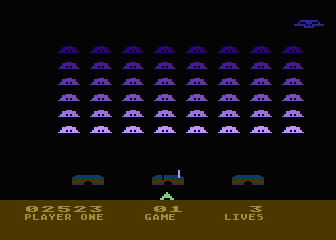|
|
Space Invaders
|
Name:
|
Space Invaders |
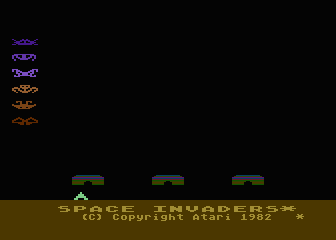 |
| Company: | Atari | |
|
Model #:
|
CX-5204 | |
|
Programmers:
|
Atari 5200 Port: Eric Manghise
(Programmer) & Marilyn Churchill (Graphics) Atari 8-Bit Version: Rob Fulop |
|
| Year: | 1982 | |
|
Released?
|
Yes
|
|
| Notes: |
Port of the
1978 Taito Coin-Op |
Space Invaders is often citied as being the first hit video game. When it was released in 1978 Space Invaders quickly soared to the top of the charts, selling over 100,000 machines in its first year alone. By the time Space Invaders hit the US in 1980 Taito had sold over 300,000 machines in Japan and would sell 60,000 units in the US in its first year of availability with each machine costing between $2,000 and $3,000. A popular urban legend stated that Space Invaders was responsible for causing a 100 Yen coin (equivalent to a US Quarter) shortage in Japan due to them all being pumped into Space Invader cabinets. As fun as this ‘fact’ is, it’s actually not true and is most likely due to less 100 Yen coins being produced that year. Atari, being well aware of Space Invader’s popularity, was the first company to officially license the game for use on home systems. The Atari 2600 port came first in mid-1980 and helped quadruple sales of the system, while the Atari 8-bit computer port was released not long after. When the Atari 5200 was released in 1982, it also received a port of Space Invaders.
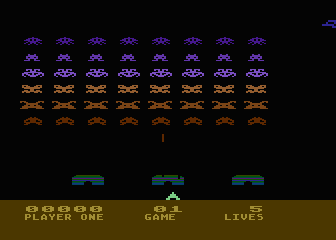
Before we talk about the Atari 5200 port of Space Invaders, we must first look at the Atari 400/800 port. This is because the Atari 5200 version of Space Invaders is actually based on the Atari 400/800 port and wasn’t a completely new version as was done with Dig Dug, Qix, and Centipede. The Atari 400/800 port (coded by Rob Fulop) polarized many Space Invaders fans with its differences and new additions. Instead of an army of Invaders appearing on the screen already in formation, the Atari computer port has them slowly marching out of a rocket which is floating on the left side of the screen. After destroying each wave on invaders this rocket will lower bit by bit until it lands on the planet surface. When this happens, the UFO will come down and take your ship away, although it comes right back so you can continue blasting Invaders. Another change was to the Invaders themselves who were given completely different graphics to make them look a bit more alien and outlandish. But perhaps the biggest change was the elimination of the shield bunkers which the player could hide behind. Why these were removed is anyone’s guess, but Rob is quoted as saying that he wasn’t told that he had to make the game exactly like the arcade version, so he added his own changes. For good or for ill, the Atari computer port of Space Invaders was very different than the arcade version.
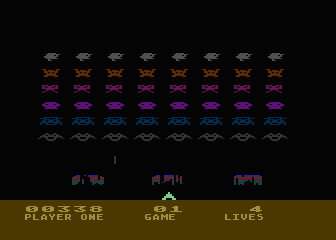
So, what about the Atari 5200 version then? Well it seems that Atari’s management decided that the 5200’s port of Space Invaders should be closer to the arcade game as the 5200 was being touted as the ‘Home Arcade Machine’. However, as stated earlier, Atari didn’t want to recode the game from scratch, instead they decided to simply add the missing features to the Atari 400/800 version. Why this was is unknown, but Atari probably didn’t want to take the time to completely redo the game as the Space Invaders craze was fading quickly. So, what changes did they make to the 5200 port? The main changes to the game are the inclusion of shields (three large bunkers where the arcade had four smaller bunkers), four completely different sets of invaders (rather than the one set from the original), a different design for the UFO, the inclusion of Trak-Ball support (listed in the manual as a ‘Future Accessory’), and the elimination of the rocket. This last change was done somewhat sloppily and the ‘ghost of the rocket’ can still be seen by the fact that the Invaders never reach the left edge of the screen where the rocket should be, and the rocket movement sound still plays between waves.
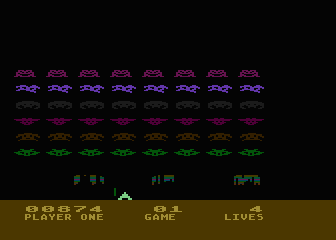
While the inclusion of different sets of Invaders added some long-term playability to the game (the final morphing Invaders are a nice touch) and the inclusion of the shield bunkers brought it closer to the arcade game, what this digital coat of paint couldn’t hide was the fact that Space Invaders was quickly becoming old news by this point. While still popular, Space Invaders was quickly being replaced by a hungry yellow circle and his supernatural pals. However while Pac-Man was properly licensed and only appeared on Atari systems (or was ported by Atari), Space Invaders was not, so other companies could continue to make ports for their systems as long as they didn’t call them Space Invaders. This meant that Space Invaders continued to be a common fixture on just about every home console and computer well into the mid-80’s.
So, is the Atari 5200 version of Space Invaders superior to the 400/800 port? That answer seems to be as polarizing as Rob’s original port. While some people appreciate the additions that make the 5200 version more like the arcade, some people preferred the 400/800 port due to the fact that it WAS different. There’s really no right or wrong answer as both ports are based on the same code and play very similar even with the 5200’s changes, so it’s a matter of personal preference. Interestingly the Atari 5200 port of Super Breakout was given a similar treatment, although the changes were much less obvious. After flirting with doing two different versions of a game for a time (one for the 400/800 and one for the 5200), Atari decided that each system would share a port. This cut down on development costs as the two systems were basically the same and the code could be ported quite easily.
| Version | Cart Text | Description |
| 4/22/82 | Space Invaders EPROM Cartridge | Final version |

